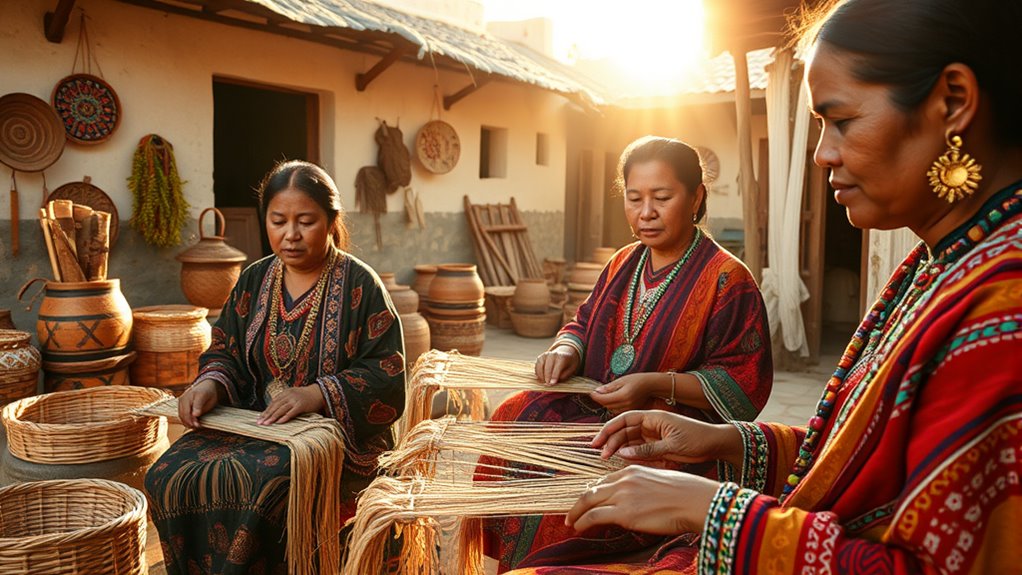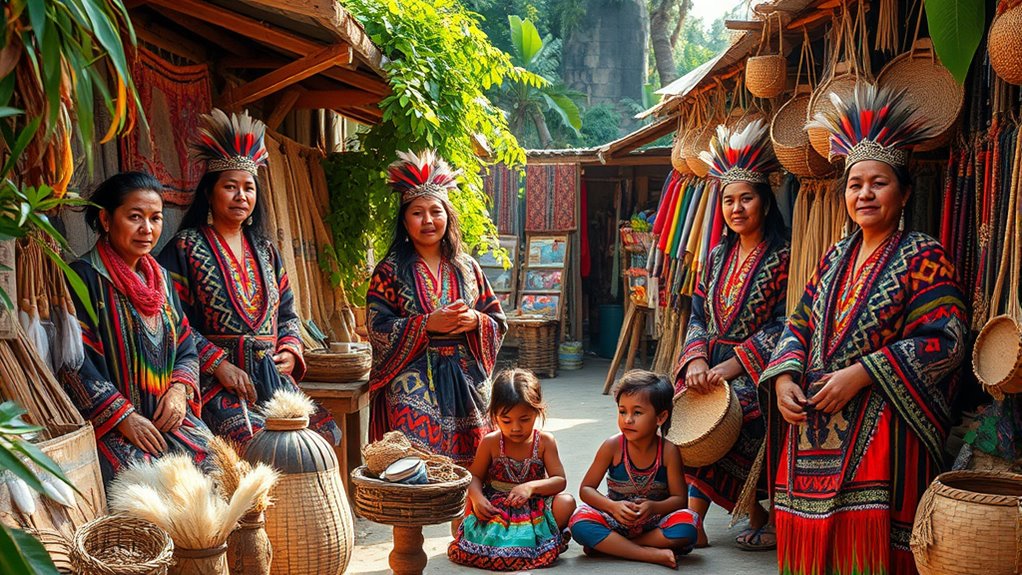By exploring traditional practices in indigenous communities, you can see how sustainable fashion blends cultural identity with eco-friendly methods. These communities use natural dyes, locally sourced materials, and resourceful techniques that minimize waste and harm to the environment. They support ethical sourcing and preserve unique cultural symbols, fostering diversity. Embracing these lessons helps you understand how fashion can be both beautiful and responsible. Keep exploring to discover how these traditions offer powerful insights for a greener, more equitable fashion industry.
Key Takeaways
- Indigenous communities use natural dyes from local plants, promoting eco-friendly and sustainable textile practices.
- Traditional techniques emphasize resourcefulness, minimal waste, and harmony with nature, inspiring responsible fashion methods.
- Sourcing materials locally supports ecological balance, ethical labor, and strengthens community economies.
- Cultural symbols and patterns in garments preserve indigenous identities and foster diversity in fashion.
- Incorporating traditional practices encourages sustainable living and highlights the importance of respecting cultural heritage.

Sustainable fashion is gaining momentum worldwide, but indigenous communities have long practiced environmentally friendly clothing methods rooted in tradition. These communities understand that clothing isn’t just about appearance; it’s a essential part of their cultural identity and heritage. When you explore their practices, you realize how deeply intertwined fashion is with cultural preservation. They use natural dyes derived from local plants, which not only minimize environmental harm but also preserve traditional knowledge passed down through generations. By respecting these age-old techniques, you see that sustainable fashion isn’t a modern invention but a continuation of centuries-old wisdom.
Indigenous communities preserve cultural identity through eco-friendly practices like natural dyes, blending tradition with sustainability.
You might be surprised to learn that ethical sourcing is at the heart of indigenous fashion practices. These communities typically source their materials locally, ensuring they support their own ecosystems and economies. Unlike fast fashion brands that often rely on exploitative supply chains, indigenous artisans harvest raw materials with care, maintaining a balance with nature. This approach guarantees that every thread and fiber respects the environment and the people who produce it. When you choose clothing inspired by or directly sourced from indigenous communities, you’re supporting ethical sourcing practices that prioritize sustainability and social responsibility.
By embracing these traditions, you also help preserve cultural identity. Indigenous artisans often incorporate symbols, patterns, and techniques unique to their communities, which hold deep cultural significance. When you wear such garments, you’re not just making a fashion statement; you’re participating in a form of cultural preservation. This connection helps keep these traditions alive in a rapidly changing world, ensuring future generations can continue to celebrate their heritage through fashion. Supporting indigenous fashion also challenges the homogenization of global styles, giving space for diverse cultural expressions to thrive.
Furthermore, learning from indigenous communities offers you valuable lessons in sustainable living. Their methods emphasize minimal waste, resourcefulness, and harmony with nature. They often repurpose leftover materials, use biodegradable dyes, and avoid harmful chemicals, demonstrating that eco-friendly practices can be both beautiful and functional. When you adopt these principles into your own wardrobe choices, you contribute to reducing your environmental footprint and promoting a more ethical, sustainable industry.
In essence, indigenous communities exemplify how fashion can be a vessel for cultural preservation and ethical sourcing. Their practices remind you that sustainability isn’t just about eco-friendly materials but also about respecting traditions, supporting local economies, and valuing cultural diversity. By recognizing and honoring these practices, you help promote a fashion industry that’s more just, responsible, and in tune with the earth and its people.
Frequently Asked Questions
How Can Indigenous Fashion Be Protected From Cultural Appropriation?
To protect indigenous fashion from cultural appropriation, you should prioritize cultural sensitivity and respect for their heritage preservation. Engage with indigenous communities directly, seek permission, and collaborate with artisans to ensure authentic representation. Educate others about the significance of traditional designs, and support ethical brands that honor indigenous rights. By doing so, you help safeguard their cultural identity while promoting sustainable and respectful fashion practices.
What Are the Economic Impacts of Sustainable Indigenous Fashion Initiatives?
You see that sustainable indigenous fashion initiatives boost economic empowerment by creating new market access for communities. When you support these initiatives, you help preserve cultural heritage while generating income for local artisans. This increased market access encourages growth, reduces poverty, and fosters community resilience. Overall, sustainable fashion initiatives positively impact indigenous economies, enabling communities to thrive financially while maintaining their traditions and promoting cultural pride.
How Do Indigenous Communities Balance Tradition With Modern Fashion Trends?
Balancing tradition with trends, you embrace cultural preservation while incorporating modern integration. You respect age-old artistry and adapt attire to fit contemporary tastes, blending traditional techniques with trendy textiles. By doing so, you honor heritage without hindering innovation, creating a fusion of fashion and forethought. This delicate dance ensures indigenous communities stay true to their roots while confidently steering through current fashion currents.
What Role Do Government Policies Play in Supporting Indigenous Sustainable Fashion?
Government policies greatly influence indigenous sustainable fashion by shaping industry standards and protecting cultural practices. You can benefit from policy influence through increased funding opportunities that support traditional artisans and eco-friendly initiatives. When policies prioritize sustainable practices, they empower you to preserve cultural heritage while innovating within modern markets. Active government involvement ensures that indigenous communities receive the necessary resources and recognition, fostering growth and sustainability in your fashion endeavors.
How Can Consumers Ethically Support Indigenous-Led Fashion Brands?
Imagine you’re shopping for a unique piece and choose a brand that partners with indigenous artisans through fair trade practices. You can support indigenous-led fashion brands by prioritizing certified fair trade items and seeking out artisan collaborations that empower local communities. Your conscious choices help preserve traditional crafts, promote ethical practices, and guarantee artisans receive fair wages. Every purchase becomes a way to respect and sustain indigenous cultural heritage.
Conclusion
Just like the wise elders of old, indigenous communities remind us that true sustainability lies in honoring tradition. By embracing their time-tested methods, you can help preserve not just fashion, but culture and environment too. In a world racing toward disposable trends, their stories offer a beacon of hope—showing that the path to a sustainable future is rooted in respect, resilience, and the wisdom of those who came before. Will you listen and learn?








